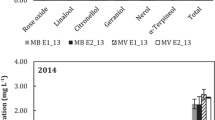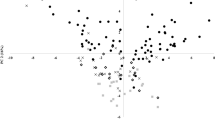Abstract
Co-winemaked Monastrell wines with Cabernet Sauvignon or Merlot, at different proportions have been studied for first time in terms of its odor activity value (OAV) in young wines, aging wines (after 9 months in French oak barrels) and bottled aging wines (aging wines after 6 months in the bottle). The co-winemaking wines showed a different aromatic complexity as they were fruitier and sweeter than the monovarietal ones, enhancing their aroma characteristics, being more evident at 60:40 proportion in case of Merlot for young and aging wines and Cabernet Sauvignon for bottled ones. In terms of extractable oak compounds, Monastrell–Merlot wines showed the highest values suggesting that they may need a shorter period within the barrel than Monastrell–Cabernet Sauvignon ones.


Similar content being viewed by others
References
Mamede M, Cardello H, Pastore G (2005) Food Chem 89:63–68
Ferreira V, Ortín N, Escudero A, López R, Cacho JF (2002) J Agric Food Chem 50:4048–4054
Peinado RA, Moreno J, Bueno JE, Moreno JA, Mauricio JC (2004) Food Chem 84:585–590
Culleré L, Escudero A, Cacho J, Ferreira V (2004) J Agric Food Chem 52(6):1653–1660
Etiévant PX (1991) Wine. In: Maarse H (ed) Volatile compounds of food and beverages. Marcel Dekker, New York, pp 483–546
Schereier P (1979) CRC Crit Rev Food Sci Nutr 12:59–111
Ramey D, Ough CS (1980) J Agric Food Chem 28:928–934
Fleet GH, Heard GM (1993) Yeast growth during fermentation. In: Fleet GH (ed) Wine microbiology and biotechnology. Harwood, Switzerland, pp 27–57
Butzke CE (1998) Am J Enol Vitic 49(2):220–224
Marchetti R, Guerzoni ME (1987) Conn Vigne Vin 21:113–125
Chatonnet P, Boidron JN, Pons M (1990) Sci Alim 10:565–587
Díaz-Plaza EM, Reyero JR, Pardo F, Alonso GL, Salinas MR (2002) J Agric Food Chem 50(9):2622–2626
Cadahía E, Fernández de Simón B, Jalocha J (2003) J Agric Food Chem 51(20):5923–5932
Garde T, Ancín C (2006) LWT-Food Sci Technol 39:199–205
Peynaud E (1984) Conservación y envejecimiento del vino. In: Mundi Prensa (ed) Enología práctica. Mundi Prensa, Madrid, Spain, pp 255–300
Monagas M, Martín-Álvarez PJ, Gómez-Cordovés C, Bartolomé B (2007) LWT-Food Sci Technol 40:107–115
Diago-Santamaría M, Boulton R (2003) In: 54th Annual Meeting of the American Society for Enology and Viticulture, Reno, NV
Bayonove C, Baumes R, Crouzet J, Günata Z (2003) Aromas. In: Flanzy C (ed) Enolología: Fundamentos Científicos y Tecnológicos. Mundi Prensa, Madrid, Spain, pp 137–145
Dubordieu D, Ollivier CH, Boidron JN (1986) Conn Vigne Vin 20(1):53–76
Boulton RB (2001) Am J Enol Vitic 52(2):67–87
Lorenzo C, Pardo F, Zalacain A, Alonso GL, Salinas MR (2005) J Agric Food Chem 53:7609–7616
Salinas MR, Zalacain A, Pardo F, Alonso GL (2004) J Agric Food Chem 52:4821–4827
Reyero JR, Garijo J, Díaz-Plaza EM, Cuartero H, Pardo F, Salinas MR (2000) Aliment Equipos Tecnol 2:101–110
ECC (1990) Off J Eur Commun L 272(3):1–192
Huerta MD, Masoud T, Salinas MR (1995) Sci Alim 15:187–191
Guth H (1997) J Agric Food Chem 45:3027–3032
Salinas MR, Alonso GL (1997) Adsorption-thermal desorption-gas chromatography applied to the determination of wine aromas. In: Lindskend HF, Jackson JF (eds) Moderns methods of plants analysis. Springer, Berlin, pp 175–192
Ferreira V, López R, Cacho JF (2000) J Sci Food Agric 80:1659–1667
Leffingwell D, Leffingwell JC (1999) Esters. Detection thresholds and molecular structures. In: Leffingwell JC (ed) Odor detection thresholds of grass flavor chemicals. Leffinwell & Associates
Chatonnet P (1991) Incidence du bois de chêne sur la composition chimique et les qualités organoleptiques des vins. Thesis, Université de Bordeaux
Chatonnet P, Dubordieu D, Boidron JN (1992) Sci Alim 12:665–685
Aiken JV, Noble AC (1984) Vitis 23:27–36
Chatonnet P, Boidron JN, Dubordieu D (1993) J Inter Sci Vigne Vin 27:277–298
Stashenko H, Macku C, Shibamato T (1992) J Agric Food Chem 40:2257–2259
Mallouchos A, Komaitis M, Koutinas A, Kanellaki M (2002) J Agric Food Chem 50:3840–3848
Ribéreau-Gayon J, Peynaud E, Ribéreau-Gayon P, Sudraud P (1976) In: Dunoud (ed) Traité d’oenologie. Sciences et techniques du vin. Dunoud, Paris, France
Versini G, Orriols I, Dalla Serra A (1994) Vitis 33:165–170
Dubois P (1994) Rev Fran d’œnol 145:27–39 and 146:39–50
Piggott JR, Findlay AJ (1984) Detection thresholds for esters mixtures In: Nykänen L, Lehtonen P (eds) Flavour research of alcoholic beverages—instrumental and sensory analysis. Foundation for Biotechnological and Industrial Fermentation Research, Helsinki, pp 189–197
Jackson RS (1994) Wine science: principles and applications. Academia Press, San Diego
Marais J, Pool HJ (1980) Vitis 19:151–164
Salinas MR, Garijo J, Pardo F, Zalacain A, Alonso GL (2005) J Sci Food Agric 85:1527–1536
Usseglio-Tomasset L (1998) In: Mundi-Prensa (ed). Química Enológica. Mundi Prensa, Madrid, Spain
Franciolo S, Torrens J, Riu-Aumatell M, López-Tamames E, Buxaderas S (2003) Am J Enol Vitic 53:158–162
Ferreira V, Fernández P, Peña C, Escudero A, Cacho JF (1995) J Sci Food Agric 67:381–392
Van der Merwe CA, Van Wick CJ (1981) Am J Enol Vitic 32:41–46
Davis CR, Wibowo D, Eschenbruch R, Lee TH, Flee GH (1985) Am J Enol Vitic 36:290–301
Shinohara T (1985) Agric Biol Chem 49:2211–2212
Jarauta I, Cacho J, Ferreira V (2005) J Agric Food Chem 53(10):4166–4177
Baumes R, Bayonove C, Barillere JM, Escudier JL, Cordonnier R (1988) Conn Vigne Vin 22(3):209–223
Salinas MR, Garijo J, Pardo F, Zalacain A, Alonso GL (2003) Am J Enol Vitic 54(3):195–202
Garde T, Torrea D, Ancín C (2004) J Food Eng 65(3):349–356
Straus CR, Gooley PR, Wilson B, Williams PJ (1987) J Agric Food Chem 35:519–524
Chatonnet P, Dubordieu P, Boidron JN, Pons M (1992) J Sci Food Agric 60:165–178
Chatonnet P (2004) La contaminación de los vinos por Brettanomyces durante la vinificación y la crianza: incidencia detección y medios de lucha. In: Encuentro enológico sobre anisoles y Brettanomyces. Causas efectos y mecanismos de control. Madrid, Spain, pp. 87–95
Etiévant PX, Issanchou S, Marie S, Ducruet V, Flanzy C (1989) Sci Alim 9:19–33
Müller CJ, Kepner RE, Webb AD (1973) Am J Enol Vitic 24:5–9
Ancín C, Garde T, Torrea D, Jiménez N (2004) Food Res Int 37:375–383
Díaz-Plaza EM, Reyero JR, Pardo F, Salinas MR (2002) Anal Chim Acta 458:139–145
Waterhouse AL, Towey JP (1994) J Agric Food Chem 42:42–48
Gómez-Míguez MJ, Gómez-Míguez M, Vicario I, Heredia F (2007) J Food Eng 79(3):758–764
Hernández-Orte P, Cacho J, Ferreira V (2002) J Agric Food Chem 50(10):2891–2899
Lambrechts MG, Pretorius IS (2000) S Afr J Vitic 21:97–129
Hernández-Orte P, Ibarz MJ, Cacho J, Ferreira V (2005) Food Chem 89(2):163–174
Díaz C, Conde JE, Méndez JJ, Pérez J (2003) Food Chem 81(3):447–452
Acknowledgments
This work has been financed by the Ministerio de Ciencia y Tecnología of Spain (Project VIN01-015-C2-1). Thanks to Antonio Alfaro for his technical assistance and Kathy Walsh for proofreading the English manuscript.
Author information
Authors and Affiliations
Corresponding author
Rights and permissions
About this article
Cite this article
Lorenzo, C., Pardo, F., Zalacain, A. et al. Differentiation of co-winemaking wines by their aroma composition. Eur Food Res Technol 227, 777–787 (2008). https://doi.org/10.1007/s00217-007-0786-6
Received:
Revised:
Accepted:
Published:
Issue Date:
DOI: https://doi.org/10.1007/s00217-007-0786-6




